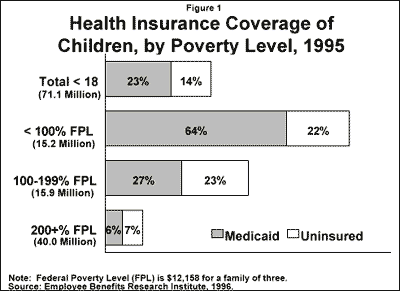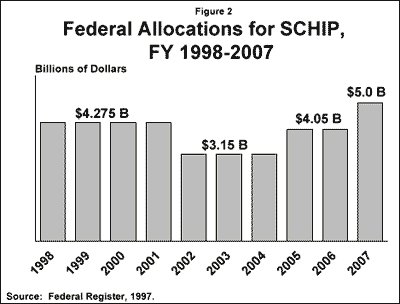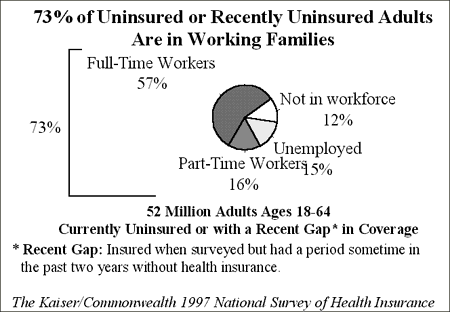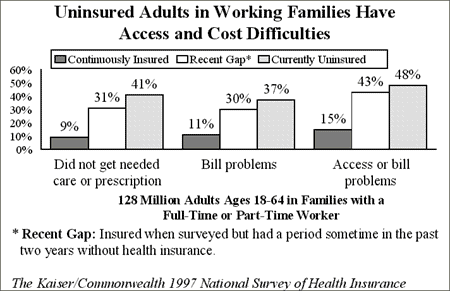Overview of Medicaid Managed Care Provisions in the Balanced Budget Act of 1997 – Report
Overview of Medicaid Managed Care Provisions in the Balanced Budget Act of 1997
Prepared by Andy SchneiderThe Center on Budget and Policy Priorities
for The Kaiser Commission on the Future of Medicaid
December 1997
This paper was prepared for The Kaiser Commission on the Future of Medicaid with support from The Henry J. Kaiser Family Foundation. The views represented in this report are those of the author and do not necessarily represent the views of The Kaiser Commission on the Future of Medicaid.
Contents
- Summary
- Medicaid Managed Care: An Overview
- Statutory Pathways to Mandatory Medicaid Managed Care
- Standards for State Contracting with Medicaid MCOs
- Payment Rates for Medicaid MCOs
- Organizational Qualifications for Medicaid MCOs
- Access and Quality Standards for Medicaid MCOs
- Beneficiary Protections
- Accountability of Medicaid MCOs for Compliance with State and Federal Standards
- Primary Care Case Management Option and Rural Beneficiaries
- Implications for Safety Net Providers
Appendices:
A. Standards for State Contracts with Medicaid MCOs
B. Index to Statutory Provisions Relating to Medicaid Managed Care
Overview of Medicaid Managed Care Provisions in the Balanced Budget Act of 1997
The Balanced Budget Act of 1997 (P.L. 105-33) dramatically expands the authority of state Medicaid agencies to provide covered health care services through managed care organizations (MCOs). The Act enables states, without obtaining waivers from the Secretary of Health and Human Services, to require most Medicaid beneficiaries to enroll in MCOs that do business only with the Medicaid program. It also allows states, again without obtaining waivers, to limit the number of participating Medicaid MCOs. These provisions are likely to have a major effect on access to covered hospital and physician services by low-income women and children and other Medicaid beneficiary populations.1 The implications of these provisions for beneficiaries, for states, for “safety net” hospitals and clinics, and for MCOs are the focus of this analysis. The budgetary and policy context in which these changes were enacted is discussed elsewhere.2
The Balanced Budget Act did not launch the shift of Medicaid from fee-for-service to managed care. That transition has been under way for several years, prompted largely by state efforts to restrain Medicaid expenditure growth and nurtured by federal waivers.3 A recent Urban Institute analysis finds that between 1991 and 1996, enrollment of Medicaid beneficiaries in managed care nationally grew from 9.5 percent to 40.1 percent of total Medicaid enrollment.4 Even before passage of the Balanced Budget Act, CBO projected that, between fiscal years 1996 and 2002, federal matching payments to Medicaid MCOs would increase, on average, more than 15 percent annually, from $7 billion, or 11 percent of federal spending on Medicaid benefits, to $17 billion, or 14 percent.5
What the Balanced Budget Act has done is to alter fundamentally the managed care policy options available to states under the federal Medicaid statute. In the past, states that wanted to require Medicaid beneficiaries to enroll in MCOs that do business mainly or exclusively with Medicaid had to obtain a waiver from the Secretary of Health and Human Services (HHS). Under the Balanced Budget Act, they will now be able to do so without seeking a waiver. State managed care initiatives currently rely heavily on the use of mostly Medicaid MCOs. In 1996, for instance, 7.7 million Medicaid beneficiaries were enrolled in 355 fully capitated managed care plans in 35 states, according to a recent analysis by Mathematica Policy Research. Of these, 3.6 million, or 48 percent, were in 156 managed care plans in which Medicaid beneficiaries accounted for more than 75 percent of total enrollment.6 The Balanced Budget Act gives states the flexibility to rely more heavily on MCOs that primarily or exclusively enroll Medicaid beneficiaries. These could include MCOs that are for-profit, MCOs that are owned by non-profit or public “safety net” providers, as well as MCOs specializing in particular services like mental health.
Under the Act, states that want to limit Medicaid beneficiaries living in urban areas to a choice between two MCOs can do so without seeking a waiver from the Secretary of HHS. States can also restrict beneficiaries living in rural areas to a single MCO. In either case, all the MCOs that a state allows to participate may do business primarily or exclusively with Medicaid. For this purpose, the managed care plans with which the state contracts can be fully capitated – that is, at financial risk for providing hospital, physician, and other covered services to Medicaid beneficiaries – or a primary care case manager (PCCM), which does not assume financial risk for the provision of covered hospital services.
This new authority translates into additional bargaining power for state Medicaid programs vis-a-vis managed care plans. States can use this leverage to obtain more favorable rates from participating plans and to limit participants to those that demonstrate the highest levels of quality in services provided. However, this bargaining power can also raise the financial rewards to winning MCOs substantially, by limiting competition, thus giving each MCO a far larger market share and a heftier revenue stream. The Medicaid managed care business can be extremely lucrative.7 The potential for favorable results in the Medicaid market has attracted venture capital firms, where, as a rule of thumb, the expected rate of return is roughly one and one-half to three times the normal market rate of return.8 This venture capital will help finance new entrants into the Medicaid managed care market as well as the expansion of firms already participating.
One attraction of Medicaid managed care as an investment opportunity is that the conversion of Medicaid beneficiaries into mandatory MCO enrollees creates large monthly flows of capitation payments. An MCO with a mandatory enrollment of, say, 30,000 Medicaid-eligible women and children at an average capitation rate of $90 per month will realize a monthly cash flow of $2.7 million and annual revenues of $32.4 million without accounting for interest. The prospect of such large revenue streams — and the potential returns to be realized in the Medicaid managed care business — are likely to prove highly attractive in many states. As new entrants seek to acquire market share and incumbent plans attempt to protect or expand their existing positions by bringing financial and other resources to bear, the state Medicaid contracting process requires careful monitoring to assure its integrity.
The Medicaid managed care business is not always financially rewarding. There is considerable variation from state to state in the Medicaid payment and regulatory policies toward MCOs. This in turn produces variations in the attraction of Medicaid as a business proposition for managed care plans. A recent review of Medicaid managed care in the trade press indicates that some investor-owned MCOs have either halted new Medicaid enrollment or withdrawn from the Medicaid market altogether in a number of states, including Arizona, Illinois, New York, Ohio, Oregon, and Tennessee. The article attributes this trend primarily to low Medicaid payment rates.9
The Balanced Budget Act alters the statutory options available to states with respect to Medicaid managed care, but it does not change the sometimes conflicting interests of states in pursuing this policy path. On the one hand, states have an interest in ensuring that their low-income families have access to basic health care services. Medicaid managed care, when properly implemented, can improve both the accessibility and quality of basic health care services for Medicaid beneficiaries, particularly in those communities in which the quality and continuity of fee-for-service care are substandard.
On the other hand, states want to limit their Medicaid expenditures. The shift from fee-for-service to managed care enables them to curb Medicaid spending on a per beneficiary basis without formally and publicly narrowing the benefits package that they offer under their Medicaid programs. States also have an interest in limiting per beneficiary payments to MCOs and allowing the MCOs to narrow the covered services enrollees actually get. How these sometimes conflicting interests are resolved will vary from state to state.
This analysis describes the new legal and policy framework within which the shift of state Medicaid programs from fee-for-service to managed care will take place over the next few years. The analysis does not duplicate section-by-section summaries of the Balanced Budget Act’s Medicaid managed care provisions.10 Instead, it focuses on those provisions that are likely to have the most influence in shaping the transition to managed care and its impact on Medicaid beneficiaries:
- standards relating to state procedures for contracting with MCOs,
- standards for MCO organizational qualifications,
- standards relating to Medicaid payment rates for MCOs,
- standards relating to accessibility and quality of care in MCOs,
- beneficiary protections,
- accountability of MCOs for compliance with these standards, and
- provisions affecting safety net providers.
The interpretation of many of these provisions here is necessarily preliminary, since as of December 19, 1997, the Health Care Financing Administration (HCFA) has issued administrative guidance to the states or to MCOs with respect to only some of these amendments.11

Endnotes
1. CBO, Budgetary Implications of the Balanced Budget Act of 1997, August 12, 1997. CBO does not attribute any federal savings to these provisions. In CBO’s view, the only budget effect of the legislation’s Medicaid managed care provisions is to increase federal spending somewhat ($0.1 billion over five years and $0.3 billion over ten) due to the requirement that Medicaid MCOs pay for hospital emergency visits whenever a “prudent layperson” would seek emergency care. 2. Andy Schneider, Overview of Medicaid Provisions in the Balanced Budget Act of 1997, P.L. 105-33, Center on Budget and Policy Priorities, Revised, September 8, 1997. www.cbpp.org/908mcaid.cfm. 3. For a detailed state-by-state survey of the scope of Medicaid managed care, see Jane Horvath et al., Medicaid Managed Care: A Guide for States, 3rd Edition, National Academy for State Health Policy, January 1997 4. Stephen Zuckerman, Alison Evans, and John Holahan, Questions for States as They Turn to Medicaid Managed Care, Urban Institute, August, 1997. 5. CBO Memorandum, Behind the Numbers: An Explanation of CBO’s January 1997 Medicaid Baseline, April 1997, p. 9. 6. Suzanne Felt-Lisk and Sara Yang, “Changes in Health Plans Serving Medicaid, 1993-1996,” Health Affairs, September/October 1997, at 127. 7. A recent report on a Medicaid-only MCO operating in Philadelphia found that between 1989 and 1996, the organization had generated pretax profits of $119 million (a return of 7,600 percent on a $200,000 investment, according to a 1994 audit), and had paid its four founders a total of $26.8 million in bonuses. Craig McCoy and Karl Stark, “An HMO Finds Lots of Money in Poverty,” Philadelphia Inquirer, August 3, 1997. A recent review of a Medicaid MCO contract by the HHS Inspector General found that one contractor realized a profit of $22.9 million over a three-year period, exceeding the IG’s “benchmark for reasonableness” by $4 million. Office of Inspector General, Department of Health and Human Services, State of Wisconsin’s Medicaid Managed Care Program Financial Safeguards, February 1997, p. 3. 8. For example, venture capital firms have invested $38 million in Americaid Community Care, which targets the Medicaid market in large urban areas like Houston and Chicago. A managing partner of Acacia Venture Partners of San Francisco, which has invested $5.5 million in Americaid, believes that Medicaid is “an exciting market, one largely ignored by the large, commercial HMOs.” Debra Gordon, “Virginia Beach-based HMO Takes the Medicaid Gamble,” The Virginian-Pilot, July 26, 1997. 9. The article quotes a health stock analyst as follows: “States have gotten reckless in cutting rates because they couldn’t care less about the Medicaid population. Only the worst HMOs, those that desperately need Medicaid will stay in.” Harris Meyer, “Medicaid: States Serve Up a Real Turkey,” Hospitals and Health Networks, November 20, 1997, p. 22. 10. For a summary section-by-section overview, see Sara Rosenbaum and Julie Darnell, A Comparison of the Medicaid Provisions in the Balanced Budget Act of 1996 (P.L. 105-33) With Prior Law, Kaiser Commission on the Future of Medicaid, September 1997. For a detailed section-by-section analysis, see National Health Law Program, National Center for Youth Law, National Senior Citizens Law Center, and Center for Medicare Advocacy, The Balanced Budget Act of 1997 – Reshaping the Health Safety Net for America’s Poor, October 1997 at www.healthlaw.org. 11. This guidance currently takes the form of letters to state Medicaid Directors. Copies are available on the HCFA Website, www.hcfa.gov/medicaid/bbahmpg.cfm.

Overview of Medicaid Managed Care Provisions in the Balanced Budget Act of 1997
Report Part One Part Two Part Three Part Four Part Five Part Six Part Seven Part Eight



